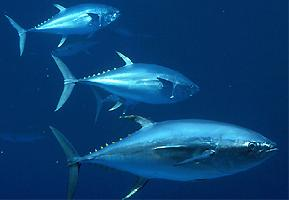
Váhy a míry
| Délka | 2 m |
|---|---|
| Hmotnost | 500 kg |
Stav ohrožení
| Ohrožen |
Popis zvířete
The Atlantic bluefin tuna, scientifically known as Thunnus thynnus, is an iconic species that roams the vast expanses of the North Atlantic Ocean and the Mediterranean Sea. This magnificent creature is among the largest and most swiftly gliding fishes in the oceanic world, capable of reaching lengths of up to 10 feet (3 meters) and weighing as much as 1500 pounds (680 kilograms). Their streamlined bodies are built for speed and endurance, allowing them to traverse thousands of miles across oceans in their migratory patterns.One of the most distinctive features of the Atlantic bluefin tuna is its remarkable coloration. The top of its body is a deep, iridescent blue, blending seamlessly into the vastness of the ocean from above, while its underside is a silvery white, providing camouflage from predators and prey alike. This coloration, coupled with its torpedo-shaped body, minimizes drag and allows for incredible bursts of speed, with recorded speeds of up to 43 miles per hour (70 kilometers per hour).
Atlantic bluefin tuna are warm-blooded, a rare trait among fish, which enables them to regulate their body temperature and inhabit a wide range of oceanic environments, from tropical to temperate waters. This physiological adaptation is particularly beneficial for their long migratory journeys and their ability to dive to depths of over 3,000 feet (900 meters) in search of prey. Their diet primarily consists of smaller fish, crustaceans, cephalopods, and occasionally eels and squids.
Reproduction in Atlantic bluefin tuna is a seasonal event, typically occurring from April to June in the Mediterranean Sea. They are known for their remarkable spawning process, where a single female can release millions of eggs, although only a tiny fraction of these will survive to adulthood. This low survival rate, coupled with their late maturity—reaching reproductive age at around 3 to 5 years—makes their populations vulnerable to overfishing.
Unfortunately, the Atlantic bluefin tuna has been subjected to intense fishing pressure for decades, primarily due to its highly prized flesh, which is considered a delicacy in many culinary traditions, especially in Japan for sushi and sashimi dishes. This demand has led to significant declines in their populations, prompting international conservation efforts aimed at sustainable management and recovery of this species.
Efforts to conserve Atlantic bluefin tuna include strict regulations on fishing quotas, improvements in fishing gear to reduce bycatch, and the establishment of marine protected areas. Scientific research plays a critical role in these conservation strategies, providing vital data on their migration patterns, breeding habits, and population dynamics, which are essential for informed management decisions.
In summary, the Atlantic bluefin tuna is a majestic and powerful marine species, whose survival is intricately linked to the health of the marine ecosystems it inhabits and the human activities that impact these environments. Its conservation presents a complex challenge, requiring international cooperation and a commitment to sustainable practices to ensure that future generations can continue to marvel at this magnificent creature of the deep.
Nové fotografie zvířat
Top 10 zvířat
- Dolphin gull (Leucophaeus scoresbii)
- Japanese macaque (Macaca fuscata)
- Stone loach (Barbatula barbatula)
- Galápagos tortoise (Geochelone nigra complex)
- Russian tortoise (Testudo horsfieldii)
- Greek tortoise (Testudo graeca)
- Diana monkey (Cercopithecus diana)
- Common flying dragon (Draco volans)
- Moustached guenon (Cercopithecus cephus)
- Galápagos penguin (Spheniscus mendiculus)